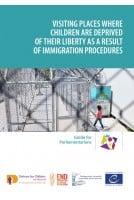



Many parliamentarians across Europe have a right to visit detention centres for irregular migrants and asylum seekers as part of their mandate as national parliamentarians. Yet a survey conducted by the Parliamentary Assembly has shown that this right is not always known to parliamentarians or used to its full capacity.
This guide therefore aims to raise awareness of this right and encourage and assist parliamentarians in carrying out visits to detention centres by:
• clarifying the right of parliamentarians to undertake such visits and explaining why it is important for them to do so;
• introducing some of the basic monitoring principles and methodology to be followed in visiting places of detention. This will include the steps for carrying out visits (preparation, conduct and follow-up);
• introducing some of the key issues and areas that should be examined during monitoring visits to places of immigration detention.
Glossary of key terms
1. What is the aim of this guide?
2. Why should parliamentarians visit places of detention?
2.1. The value added of visiting places of detention
2.2. The specific added value of parliamentarians visiting places of detention
2.3. Other organisations visiting places of detention
2.4. Visiting mandate and powers
2.5. Types of visit
3. What are the basic legal norms relating to the detention of irregular migrants and asylum seekers?
3.1. Legality and legitimate grounds for detention
3.2. Obligation to first consider non-custodial measures
3.3. Length of detention
3.4. Detention conditions
3.5. Particular considerations in the detention of certain groups
4. How to carry out visits to places where asylum seekers and irregular migrants are held
A. The preparation of the visit
4.1. Defining the objectives of the visit
4.2. Setting up the visiting team and organising the work
4.3. Collecting available information
B. The conduct of the visit
4.4. What should one pay attention to when visiting places of immigration detention?
4.5. The arrival and the initial talk with the head of the centre
4.6. Overview of the premises and observations
4.7. Consultation of registers and other documents
4.8. Talks with detainees
4.9. Contact and discussions with staff
4.10. The final talk with the head of the centre
C. The follow up to the visit
Appendices
Annex 1: Checklist of issues that could be examined during the visit
Annex 2: Example of internal visit note
Annex 3: Working with an interpreter
Annex 4: Summary table of the key principles
Annex 5: Selection of instruments and legal norms
Annex 6: Additional readings and sources
Annex 7: Tips for parliamentarians




Many parliamentarians across Europe have a right to visit detention centres for irregular migrants and asylum seekers as part of their mandate as national parliamentarians. Yet a survey conducted by the Parliamentary Assembly has shown that this right is not always known to parliamentarians or used to its full capacity.
This guide therefore aims to raise awareness of this right and encourage and assist parliamentarians in carrying out visits to detention centres by:
• clarifying the right of parliamentarians to undertake such visits and explaining why it is important for them to do so;
• introducing some of the basic monitoring principles and methodology to be followed in visiting places of detention. This will include the steps for carrying out visits (preparation, conduct and follow-up);
• introducing some of the key issues and areas that should be examined during monitoring visits to places of immigration detention.
